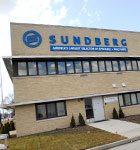At a Glance
Location
West Deptford, NJ
Founded
August 2002
Employees
25
Specialty
Rehabilitation of natural gas and pressure pipelines
Annual Revenue
More than $5 million
Your business occupies a specialty niche. Can you explain a little about PPM’s focus?
David Wickersham: PPM’s goal is to become the nation’s largest pipeline-rehabilitation contractor—with a focus on natural gas and pressure pipelines. With the increasing importance of rebuilding the nation’s deteriorating underground infrastructure, the use of trenchless—or, no-dig—technologies has evolved into a multibillion-dollar industry. We utilize Starline, a patented cured-in-place-lining [CIPL] technology focused on natural gas and pressure pipelines, a process that uniquely positions us to be the industry leader.
How did you start in this field?
DW: In 2001 I was contacted by Exelon Infrastructure to assist them on a pipeline decontamination project in Philadelphia, which is where I witnessed the Starline CIPL technology for the first time and was instantly impressed with the process and end result. At the time, the technology was licensed to Exelon, but later that year Exelon decided to bow out of the rehabilitation business.
Their exit opened an opportunity, so I polled some existing users of the process to ensure there was growth potential, and the overwhelming answer was “Yes.” From there, I formed PPM in August 2002 and negotiated a new license agreement with Karl Weiss, a subsurface-engineering firm located in Berlin and the patent holder of the Starline technology.
Were you concerned about taking a chance with an evolving technology?
DW: Actually, by the time we formally started PPM, we had projects waiting in the pipeline, to use a pun. We also had an instant bond [with] and excellent cooperation from our friends and partners at Karl Weiss, which allowed us to hit the ground running. The technology also had been put through stringent and significant testing from the US natural gas industry, so I felt very comfortable with the merits of the process.
Your clients are in critical industries such as nuclear power. How does PPM’s work keep these clients up and running?
DW: Aging infrastructure in industries such as nuclear plants and municipal gas companies requires, in most cases, expensive repair or replacement costs when a leak is detected. Excavating and replacing these aging pipelines is difficult at best because of where the pipeline may have been installed originally. The practice of “replace rather than rehabilitate” is not only more costly but also very intrusive, especially when miles of underground piping crisscross, leaving no additional room for a new pipeline. By contrast, lining old pipes [already] in place does not disturb the surrounding substructure, making the process of rehabilitation very attractive.
How do PPM’s techniques make the industries you work for safer?
DW: Safety related to the practice of leak repair is handled in two primary ways: spot repair that addresses only a specific leak—leaving an old pipeline behind, ready to leak again—or a complete rehabilitation that addresses the entire pipeline, which means it will never leak again. Once the pipeline is rehabilitated, it has the same life span [more than 50 years] as a newly installed pipeline—without the cost, time, disruption, and environmental impact associated with full replacement and excavation.
What gives PPM its competitive edge?
DW: PPM looks at each project as an individual challenge. We do not—and cannot—have a cookie-cutter methodology to rehabilitation. For example, a recent project involved the trenchless renewal of approximately 700 feet of a leaking 16-inch-diameter cast-iron gas main installed in the early 1900s and operating in a complicated schematic that included an active railroad and excessive depths. Due to emergency circumstances, the project also started in winter 2011, which was plagued with severe weather conditions. The gas main was totally inaccessible using normal construction repair [and] replace methods, so PPM had to design, develop, and test entirely new methods for solving the multiple complicated challenges encountered at each step of the project.
What is PPM working on now that is particularly exciting?
DW: PPM is currently working with Cornell University to test the Starliner’s ability to withstand seismic movement. The importance of this testing is to illustrate the flexibility of the liner and showcase its resilience to ground movement. We all remember the issues at the Fukushima Daiichi nuclear plant after the devastating earthquake hit Japan’s east coast in 2011. Earthquakes cause extensive damage to underground infrastructure, [and this is particularly dangerous at] nuclear plants, so lining pipelines can help avoid the catastrophic disaster associated with damaged pipelines and broken fire-suppression systems. ABQ


